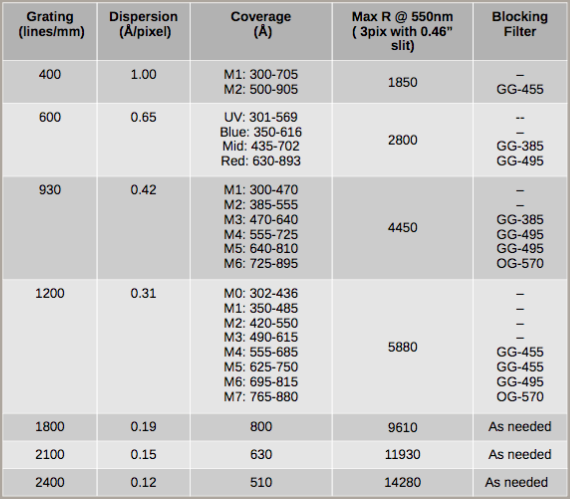Goodman Spectrograph Gratings
Updated Apr 2024.
Up to three (3) gratings can be installed in the spectrograph at a time, in a linear stage which allows the rapid interchange of gratings. Installing different gratings is a day time operation. No grating installations are done during the night.
NEW (Apr 2024):
A new 1200 l/mm grating is now available. This VPH grating has been designated 1200CaNIR, and is optimized for best throughput in the Ca II (8498, 8542, 8662A) triplet region. Its measured wavelength range is 7670 - 8810 A.
| Grating designation | Match with this Goodman Camera | Recommendation | |||||||
|---|---|---|---|---|---|---|---|---|---|
| 400 | BLUE or RED | UV to far red. Use BLUE camera if observing below ~4500A | |||||||
| 600OLD | BLUE or RED | UV to ~6000A. Use BLUE camera if observing below ~4500A | |||||||
| 600RED | RED | Use for observations redward of ~6000A | |||||||
| 930 | BLUE or RED | UV to far red. Use BLUE camera if observing below ~4500A | |||||||
| 1200BLUE | BLUE | Use for observations below ~4500A. | |||||||
| 1200BLUE | BLUE or RED | Observations between ~4500 - 5500A | |||||||
| 1200RED | RED | Use if observing beyond ~5500A. | |||||||
| 1200CaNIR | RED | Optimized for the Ca II (8498, 8542, 8662) triplet. | |||||||
| 1800 | BLUE or RED | UV to red. Use BLUE camera if observing below ~4500A | |||||||
| 2100 | BLUE or RED | UV to red. Use BLUE camera if observing below ~4500A | |||||||
| 2400 | BLUE or RED | UV to red. Use BLUE camera if observing below ~4500A | |||||||
Long Wavelength Limit for High Resolution Gratings
Because of limits in the camera rotation stage, it is not possible to use the 1800, 2100 and 2400 l/mm gratings beyond the central wavelengths indicated below:
- 1800 l/mm grating: Littrow mode centered at 760nm, spans 7200 A - 8000 A
- 2100 l/mm grating: Littrow mode centered at 650.8nm, spans 6130 A - 6710 A
- 2400 l/mm grating: Littrow mode centered at 565nm, spans 5395 - 5905 A
The table below shows the dispersion and wavelength coverage for observations in our preset spectroscopic modes. Please note that the 1800, 2100, and 2400 l/mm gratings are operated in Custom mode (Littrow Configuration), in which the observer selects the central wavelength for their observations.
The VPH gratings operate via Bragg scattering and their efficient operation requires Littrow or near-Littrow operation of the spectrograph. A grating rotation stage sets the incident angle to the desired value, which depends upon the line density of the grating and the central wavelength of interest. A concentric camera rotation stage must then be set to nearly twice this angle to intercept the diffracted beam. A set of fixed observing modes for each grating are given below, where applicable. All gratings can be used in the Custom mode.
Updated on April 25, 2024, 7:04 pm
